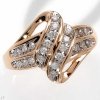Millionaire loses missing diamond case against Shangri-La Hotel

AsiaOne
Wednesday, Oct 26, 2011
An American millionaire who sued the Shangri-La Hotel after losing a diamond ring has lost her case in the High Court.
The American multi-millionaire businesswoman and philanthropist sued Shangri-La Hotel for the loss of her diamond ring during her stay there from Feb 4 to 7, 2009.
She sought compensation of US$220,000 (S$278,000) for the gold ring, which had a 6.41 carat diamond.
That is how much it would cost Ms Bass to get the ring reproduced, according to a valuation dated Feb 10, 2009, by Mr Joel Arthur Rosenthal, a famous, ultra-exclusive jeweller better known as JAR.
Mr Rosenthal sold her the ring 25 years ago.
She told the court that she wore the ring throughout her stay here, but took it off and placed it on the dressing table in the bedroom at about 6.30pm on Feb 6, 2009, after she opened the door of her suite to let two hotel employees - a massage therapist and her assistant - in.
She left them in the living room to go to the bathroom - located inside the bedroom of the suite - to change into a robe for a massage. The assistant left after setting up the massage table while the therapist left the suite at about 7.30pm after giving the massage.
About two hours later, a butler delivered Ms Bass' room service order while she was in the shower. She said she put on her robe to open the door, let him into the living room, where he placed the food trolley, and returned to the bathroom to resume her shower.
She discovered the ring was missing at 10pm, about half an hour after the butler's visit, when she had finished packing to check out.
Ms Bass blamed the loss on negligent hotel staff and alleged that one of the staff had taken it.
Justice Judith Prakash dismissed her claims as "weak and purely circumstantial", and also said she had embellished her version of the events.
Justice Prakash also found discrepancies and inconsistencies in her story, saying that there was no convincing evidence to say that Ms Bass had brought the ring to Singapore.
The hotel security team had also cooperated fully with the police during investigations, said Justice Prakash, countering claims that they were negligent.
She added that even if the ring was lost within Shangri-La premises, Ms Bass would only have been able to claim a maximum of $500 - a provision under the Innkeepers Act which limits liability for the loss.
Shangri-La general manager Michael Cottan told The Straits Times that the hotel was grateful the court had ruled in its favour, adding that the safety and security of guests has always been Shangri-La's top priority.

AsiaOne
Wednesday, Oct 26, 2011
An American millionaire who sued the Shangri-La Hotel after losing a diamond ring has lost her case in the High Court.
The American multi-millionaire businesswoman and philanthropist sued Shangri-La Hotel for the loss of her diamond ring during her stay there from Feb 4 to 7, 2009.
She sought compensation of US$220,000 (S$278,000) for the gold ring, which had a 6.41 carat diamond.
That is how much it would cost Ms Bass to get the ring reproduced, according to a valuation dated Feb 10, 2009, by Mr Joel Arthur Rosenthal, a famous, ultra-exclusive jeweller better known as JAR.
Mr Rosenthal sold her the ring 25 years ago.
She told the court that she wore the ring throughout her stay here, but took it off and placed it on the dressing table in the bedroom at about 6.30pm on Feb 6, 2009, after she opened the door of her suite to let two hotel employees - a massage therapist and her assistant - in.
She left them in the living room to go to the bathroom - located inside the bedroom of the suite - to change into a robe for a massage. The assistant left after setting up the massage table while the therapist left the suite at about 7.30pm after giving the massage.
About two hours later, a butler delivered Ms Bass' room service order while she was in the shower. She said she put on her robe to open the door, let him into the living room, where he placed the food trolley, and returned to the bathroom to resume her shower.
She discovered the ring was missing at 10pm, about half an hour after the butler's visit, when she had finished packing to check out.
Ms Bass blamed the loss on negligent hotel staff and alleged that one of the staff had taken it.
Justice Judith Prakash dismissed her claims as "weak and purely circumstantial", and also said she had embellished her version of the events.
Justice Prakash also found discrepancies and inconsistencies in her story, saying that there was no convincing evidence to say that Ms Bass had brought the ring to Singapore.
The hotel security team had also cooperated fully with the police during investigations, said Justice Prakash, countering claims that they were negligent.
She added that even if the ring was lost within Shangri-La premises, Ms Bass would only have been able to claim a maximum of $500 - a provision under the Innkeepers Act which limits liability for the loss.
Shangri-La general manager Michael Cottan told The Straits Times that the hotel was grateful the court had ruled in its favour, adding that the safety and security of guests has always been Shangri-La's top priority.




